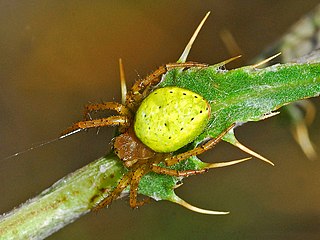
Scaffold web spiders (Nesticidae) is a family of araneomorph spiders closely allied with tangle web spiders. Like the "Theridiidae", these spiders have a comb of serrated bristles on the hind tarsi that are used to pull silk bands from the spinnerets. It contains 16 genera and about 300 species, many of which are associated with caves or overhangs. The genus Nesticus is the type for the family and is found throughout the world. The related Eidmannella has speciated considerably in Texas caves and includes some extremely localized species that are considered threatened. One species, Eidmannella pallida, is found in caves and under overhangs, but also in agricultural fields and other habitats away from such restricted areas. The genus Carpathonesticus is found in central Eurasia.

Dyspnoi is a suborder of harvestmen, currently comprising 43 extant genera and 356 extant species, although more species are expected to be described in the future. The eight families are currently grouped into three superfamilies: the Acropsopilionoidea, Ischyropsalidioidea, and Troguloidea.

Hans Henderickx (1961–2016) was a Belgian entomologist specializing in Invertebrates born in Mol, Belgium.
This list of fossil arthropods described in 2012 is a list of new taxa of trilobites, fossil insects, crustaceans, arachnids and other fossil arthropods of every kind that have been described during the year 2012. The list only includes taxa at the level of genus or species.

Kryptonesticus is a genus of European scaffold web spiders first described by Pavlek & Ribera in 2017. All but the type species were transferred from Nesticus. With the exception of K. eremita, individual species have very restricted ranges.
Speleoticus is a spider genus in the family Nesticidae. Its species are found in Japan and China.
Carpathonesticus lotriensis is an araneomorph spider species of the family Nesticidae. It occurs in Romania, where it can be found in caves.
Domitius menozzii is an araneomorph spider species of the family Nesticidae. It occurs in Italy, where it can be found in caves. It was described by Ludovico di Caporiacco in 1934.
Carpathonesticus simoni is an araneomorph spider species of the family Nesticidae. It occurs in Romania, where it can be found in caves. It was transferred from the genus Nesticus to Carpathonesticus in 1980 by Lehtinen and Saaristo.
Carpathonesticus spelaeus is an araneomorph spider species of the family Nesticidae. It occurs in Romania, where it can be found in caves and outdoors under calcareous blocks. It was transferred from the genus Nesticus to Carpathonesticus in 1980 by Lehtinen and Saaristo.
Carpathonesticus zaitzevi is an araneomorph spider species of the family Nesticidae that occurs in Georgia. It was transferred from the genus Nesticus to Carpathonesticus in 1996.
Domitius is a genus of European scaffold web spiders first described by C. Ribera in 2018.

Araniella opisthographa is a species of orb weaver in the spider family Araneidae.

Nesticus cellulanus, also known as the cavity spider or comb-footed cellar spider, is a species of scaffold web spider. It is found throughout Europe and Turkey, and has been introduced to North America.





